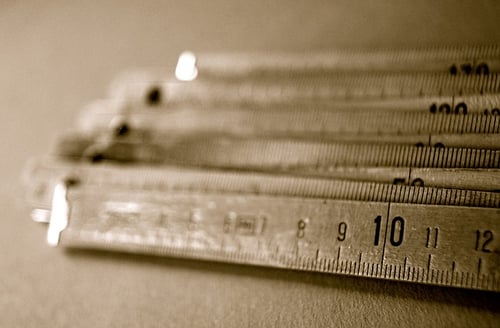
If you’re interested in studying a field such as biology or computer engineering, knowing how to convert nanometers to meters (or nm to m) will be a vital skill to have.
In this guide, we'll go over exactly what a nanometer is and what it measures. We’ll then give you three methods you can use for converting nm to m. Finally, we’ll provide you with a chart that shows various conversions from nanometers to millimeters, centimeters, decimeters, and more.
What Is a Nanometer? A Meter?
Nanometers and meters are both units of measurement that are used to measure length. A meter (m) is the basic unit of length in the International System of Units, or what is typically known as the metric system. One meter is equivalent to approximately 3.28 feet in the Imperial system, which is used in the United States and a smattering of other countries.
A nanometer (nm) is equal to one-billionth of a meter. The prefix "nano" literally means one-billionth. Written out, one nanometer looks like 0.000000001 m (that’s nine zeros!).
It can be a little long to write out fully, though, so another option is to use exponents. A calculator will most likely show you 1e-9 for one-billionth, meaning 1 * 10-9. So if you’d rather write out one-billionth using exponents, you could do 1 * 10-9, or even just 10-9.
To help you understand the relationship between nm and m, let’s look at an analogy provided by the National Nanotechnology Initiative:
"If the diameter of a marble [were] one nanometer, then [the] diameter of the Earth would be about one meter."
That’s a gigantic difference and goes to show just how much bigger one meter is compared to one nanometer!
What Are Nanometers Used to Measure?
One nanometer is so small, it’s invisible to the human eye. Nanometers are generally used to measure microscopic things, both man-made and natural, such as molecules, atoms, and the tiny components used in computer processors.
Your fingernails grow about 1 nm each second. That’s around 86,400 nm each day—but that’s still such a small length that you wouldn’t even notice it!
Still not understanding just how small a nanometer really is? Imagine a ruler. You probably have a decent grasp of how big a centimeter is. Remember that 10 millimeters fit into one centimeter, so millimeters are already pretty small. Now listen to this: there are one MILLION nanometers in just one millimeter!
The following chart will give you a better idea of how many nanometers there are in various things you can (and cannot!) see with the naked eye in the world around you:
|
Specimen |
Length in Nanometers |
|
Dust mite |
200,000 nm |
|
Sheet of paper (thickness) |
100,000 nm |
|
Human hair (thickness) |
80,000-100,000 nm |
|
Red blood cell |
7,000-8,000 nm |
|
Bacterium |
2,500 nm |
|
Nanoparticle (diameter) |
4 nm |
|
Human DNA (diameter) |
2.5 nm |
|
Atom |
0.1-0.2 nm |

3 Methods for Converting Nanometers to Meters
There are a few ways you can convert nm to m. We go over each of these below.
Method 1: Set Up a Conversion Equation
The first conversion method is to set up an equation.
Recall that 1 m is equivalent to 1,000,000,000 nm. To use this nm-to-m method, you’ll want to write this as a fraction:
$${1 \m}/{1,000,000,000 \nm}$$
Let’s say you were given a measurement of 12,358 nm. To convert this to meters, all you need to do is multiply the measurement in nm by the conversion factor (the fraction above). Here is what this would look like written out:
$$12,358 \nm=12,358{1/1,000,000,000}$$
$$12,358 \nm=0.000012358 \m$$
If you wanted to convert a measurement from m to nm, simply flip the conversion factor upside down so that it looks like this:
$${1,000,000,000 \nm}/{1 \m}$$
Because the denominator is 1, this fraction is the same as 1,000,000,000. Therefore, you can just multiply your measurement in m by 1,000,000,000 to get its conversion in nm.
Method 2: Move the Decimal
Another method you can use for converting nm to m is moving the decimal over. Nanometers and meters are based on units of 10 (like the whole of the metric system), so converting between units is really about moving the decimal.
Because 1,000,000,000 nm equals 1 m, converting from nanometers to meters consists of simply moving the decimal point to the left nine places.
Let’s look at an example. Say you have a dust mite that is 205,449.13 nm in length. To convert this measurement to meters, all you have to do is move the decimal point to the left nine places:

By doing this, you should get the following:
$205,449.13 \nm=0.00020544913 \m$
If you have a whole number, such as 682 nm, the decimal point will be after the last number (think of it like 682.0 nm), so you’ll start from there before moving it to the left nine places to get your conversion, which in this case would be 0.000000682 m.
Method 3: Use an Online Conversion Tool
The final nm-to-m conversion method you can use is an online conversion tool.
Many websites offer free conversion tools you can use to quickly and accurately convert a certain measurement from nanometers to meters. All you need to do is input the measurement in nm and you’ll be given the conversion in m instantly.
Available conversion tools we recommend using include The Calculator Site, which offers a helpful reference chart, and FormulaConversion.com, which lets you see the conversions right as you add, subtract, and/or change numbers.
You can use any online nm-to-m conversion calculator, just as long as it’s accurate. If you’re not sure whether the answer the tool gives you is correct or not, try one of the two methods above to double-check your answer.
 Can you figure out how many nm are in 20 km?
Can you figure out how many nm are in 20 km?
How Many Nanometers Are in a Meter? In a Kilometer?
It's definitely helpful to know how to convert nm to m, but what about converting nanometers to centimeters? To micrometers? To kilometers?
The following chart gives a brief overview of various conversions, all the way from nm to km:
|
Measurement |
Conversion in Nanometers |
|
1 kilometer (km) |
1,000,000,000,000 nm (one trillion) |
|
1 hectometer (hm) |
100,000,000,000 nm (one hundred billion) |
|
1 decameter/dekameter (dam/dkm) |
10,000,000,000 nm (ten billion) |
|
1 meter (m) |
1,000,000,000 nm (one billion) |
|
1 decimeter (dm) |
100,000,000 nm (one hundred million) |
|
1 centimeter (cm) |
10,000,000 nm (ten million) |
|
1 millimeter (mm) |
1,000,000 nm (one million) |
|
1 micrometer (μm/um) |
1,000 nm (one thousand) |
| 1 nanometer (nm) | 1 nm |
What’s Next?
Trying to study for SAT Math? Then take a look at our expert guide to the SAT Math section and learn how you can get a perfect score on it.
Curious about how Celsius converts to Fahrenheit? Our in-depth guide walks you through the #1 trick to know so that you can quickly convert between these temperature units.
How do you convert decimals to fractions? And what about cups to quarts? Read our guides to learn all the tips and tricks out there!
Have friends who also need help with test prep? Share this article!

Hannah received her MA in Japanese Studies from the University of Michigan and holds a bachelor's degree from the University of Southern California. From 2013 to 2015, she taught English in Japan via the JET Program. She is passionate about education, writing, and travel.

































 Holly R.
Holly R.